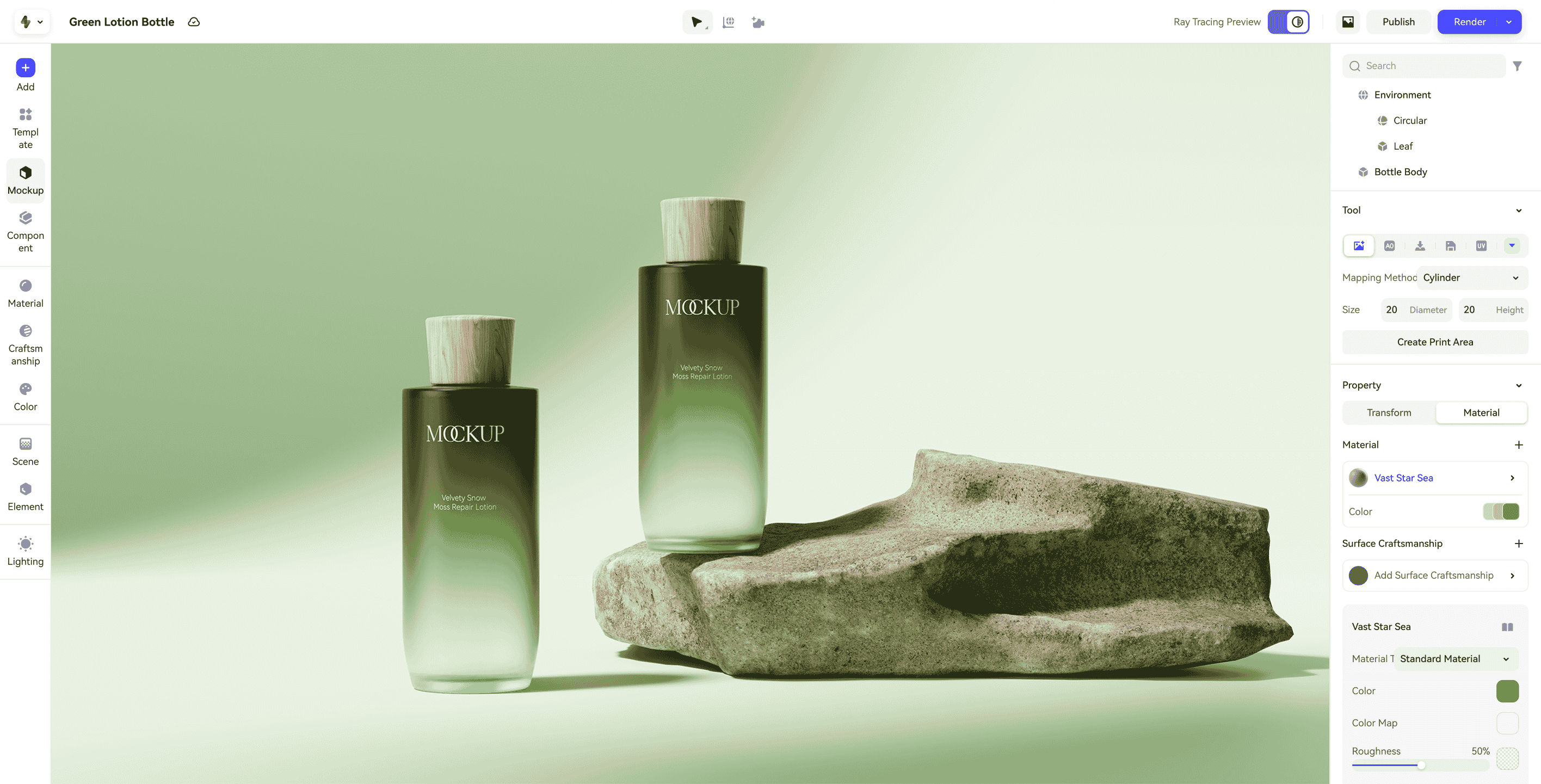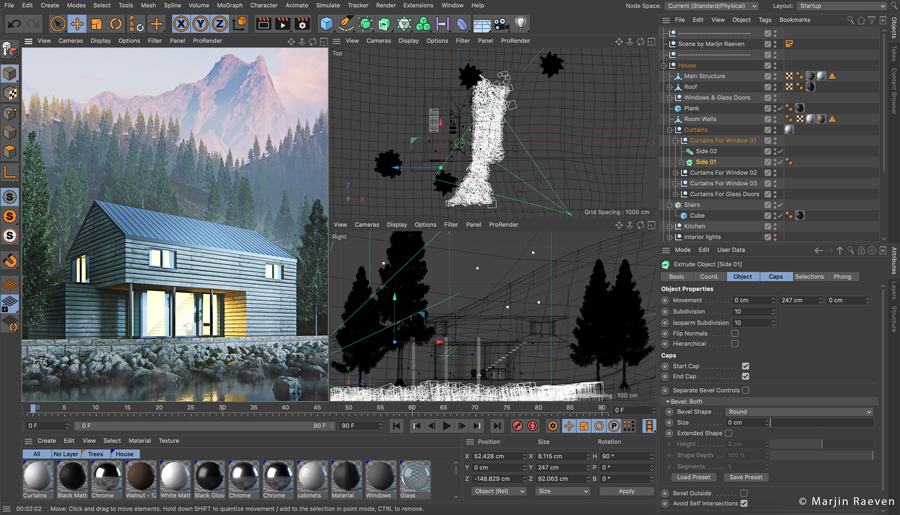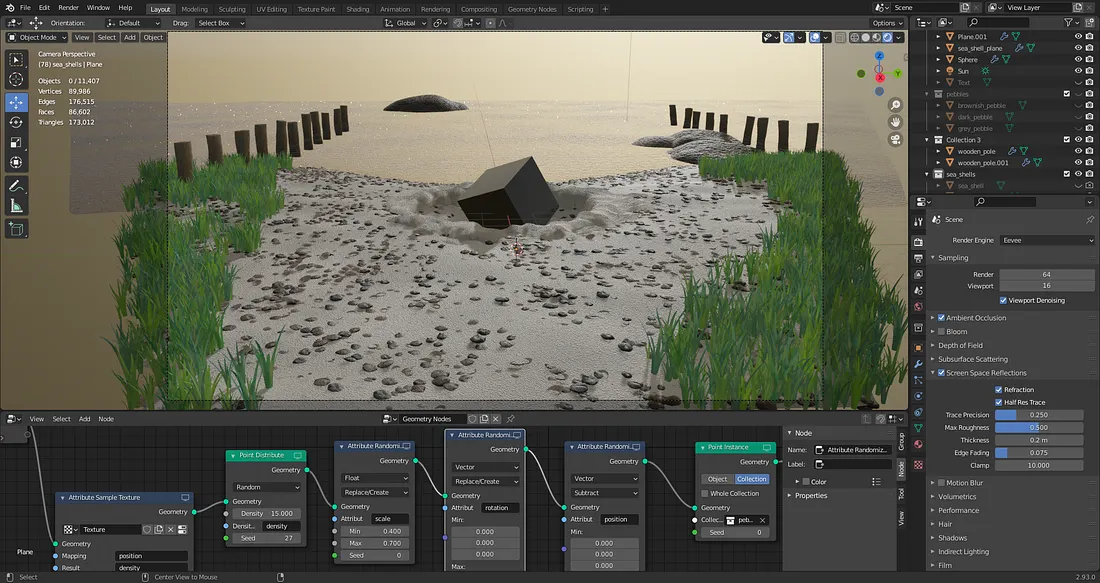As a designer who has built a career on a MacBook Pro, I've lived the paradox of modern 3D work. We wield machines of incredible power, yet our days are often dictated by the agonizing crawl of a progress bar. The leap to Apple Silicon felt like a revolution—a sudden, breathtaking surge of performance. And yet, the fundamental frictions persisted. The colossal project files, the Byzantine ritual of sharing drafts, the collaboration bottlenecks... they remained, stubborn ghosts in our very powerful machines. It was a gilded cage. This realization forced a question: What if the bottleneck isn't the machine itself? What if it's the process?
This is not just another list. This is a guide to reclaiming your creative flow. We will journey through the landscape of 3D rendering software for Mac, weighing the raw power of traditional desktop titans against the fluid intelligence of a new, cloud-native paradigm. The mission is to find the tool that doesn't just make pixels, but makes your entire creative life better.
Why Your Choice of Renderer Matters More Than Ever
We stand at a fascinating inflection point. The raw horsepower of our Macs is no longer the primary question. The real challenge is translating that power into creative velocity. To choose the right software today is to choose your entire philosophy of work.
The Silicon Renaissance
Apple Silicon wasn't just an upgrade; it was a fundamental architectural shift. The unified memory is a masterstroke, allowing the CPU and GPU to communicate with an intimacy previously unimaginable. For 3D artists, this translates into a tangible, fluid experience—smoother viewports, faster previews, the ability to sculpt and paint on models of staggering complexity. But running non-optimized software on these chips is like owning a Stradivarius and only knowing how to play "Twinkle, Twinkle, Little Star." Native support isn't a feature; it's the price of admission to this new era of performance.
The Anatomy of a Broken Workflow
Beyond the silicon, a more insidious problem festers in the traditional 3D pipeline. It's a story of friction, a thousand tiny cuts that bleed time and creativity:
 The Render Hostage: You hit "Render," and your thousand-dollar machine transforms into a very expensive space heater, holding your workflow hostage for hours.
The Render Hostage: You hit "Render," and your thousand-dollar machine transforms into a very expensive space heater, holding your workflow hostage for hours. The Versioning Chaos: Project-Final-v2-client-edits-FINAL-use-this-one.zip Does this sound familiar? Managing massive, disconnected files is a disaster waiting to happen.
The Versioning Chaos: Project-Final-v2-client-edits-FINAL-use-this-one.zip Does this sound familiar? Managing massive, disconnected files is a disaster waiting to happen. The Communication Void: The cycle of exporting, uploading, emailing, and then deciphering feedback from a dozen scattered replies is a slow, soul-crushing dance.
The Communication Void: The cycle of exporting, uploading, emailing, and then deciphering feedback from a dozen scattered replies is a slow, soul-crushing dance. The Digital Silo: Your masterpiece is trapped on one machine, a brilliant but lonely creation inaccessible to a collaborator across the office, let alone across the globe.
The Digital Silo: Your masterpiece is trapped on one machine, a brilliant but lonely creation inaccessible to a collaborator across the office, let alone across the globe.
It's this daily grind, this operational drag, that demands a new class of tools—tools built not just for rendering, but for creating and collaborating in the 21st century.
The Top 5 3D Rendering Tools for Mac: A Deep Dive
Let's dissect the best options available, starting with the solution that fundamentally altered my team's creative metabolism.
1. Realishot: The Cloud-Native Studio for Collaborative Teams
This isn't just another app on the list; it's the catalyst for the conversation. Realishot doesn't install on your Mac; it awakens in your browser. It’s a paradigm shift, an answer to the "what if" questions we designers have been asking for years. As someone who must bridge the gap between pixel-perfect design and market-moving strategy, I see Realishot not as a tool, but as a strategic asset.
 Realishot Online Rendering
Realishot Online Rendering
Its Core Philosophy, Expressed as Features:
 Your Studio, Everywhere: The tyranny of the local install is over. Imagine accessing your entire 3D workspace from any Mac, at any time, with nothing but a web browser. It decouples your creativity from a single piece of hardware, liberating your team to work with a fluidity previously impossible.
Your Studio, Everywhere: The tyranny of the local install is over. Imagine accessing your entire 3D workspace from any Mac, at any time, with nothing but a web browser. It decouples your creativity from a single piece of hardware, liberating your team to work with a fluidity previously impossible. Ending the Tyranny of the Export Button: Collaboration in Realishot is as simple as sharing a URL. A link becomes a living canvas where clients and colleagues can orbit, inspect, and annotate your work in real-time. The endless loop of exporting, compressing, and emailing is replaced by a single, elegant conversation.
Ending the Tyranny of the Export Button: Collaboration in Realishot is as simple as sharing a URL. A link becomes a living canvas where clients and colleagues can orbit, inspect, and annotate your work in real-time. The endless loop of exporting, compressing, and emailing is replaced by a single, elegant conversation. A Bridge to Figma, A Leap for Productivity: For anyone working with packaging or UI, the direct Figma integration is nothing short of revolutionary. Your 2D designs flow onto your 3D models as if by magic, transforming a tedious, multi-step process into a seamless, creative dialogue between dimensions.
A Bridge to Figma, A Leap for Productivity: For anyone working with packaging or UI, the direct Figma integration is nothing short of revolutionary. Your 2D designs flow onto your 3D models as if by magic, transforming a tedious, multi-step process into a seamless, creative dialogue between dimensions.
On Apple Silicon Performance:
Here is where Realishot rewrites the rules of local rendering. This isn't the magic of a distant cloud farm; it's the tangible magic of radical optimization, a deep synergy between our software and Apple's silicon. The experience is almost uncanny. On what many would now consider a base-model M1 Pro MacBook, I can launch a demanding, light-bounced ray tracing render and... nothing dramatic happens. The fans remain a whisper, not a roar. My machine doesn't buckle under the strain. This is the critical difference: I can seamlessly switch to another task—be it finalizing a presentation, diving deep into Figma, or managing team communications—while Realishot quietly crafts a perfect image in a browser tab. It treats rendering not as a system-hijacking event, but as a well-behaved, efficient process. It reclaims your machine from the tyranny of the render queue. And when you unleash Realishot on a more powerful chip, like an M2 or M3 Max? The performance ascends to an entirely new level. You can push every visual setting to its 'Ultra' peak, manipulating complex scenes with full, glorious ray tracing in real-time, and the machine simply keeps pace, asking for more. This isn't just running software on a Mac; this is the true promise of Apple Silicon, fully and elegantly unlocked.
%20(1)-v0j353.png) Effect of Realishot Online Ray Tracing Rendering
Effect of Realishot Online Ray Tracing Rendering
My Personal Take:
The moment that truly defined Realishot for me was on a tight deadline. A client requested a last-minute material change across an entire product line. In the old world, that meant a weekend of re-rendering, a symphony of whirring fans and frayed nerves. With Realishot, it was a 15-minute task. We made the change, re-queued the renders in the cloud, and went to dinner. It didn't just save time; it saved our sanity. It transforms rendering from a bottleneck into a background utility, like electricity or water. It's just *there*.
2. Maxon Cinema 4D (with Redshift): The Maestro of Motion
To discuss 3D on a Mac without venerating Cinema 4D would be heresy. It is the German-engineered powerhouse of motion graphics, a tool of immense depth and stability. Its MoGraph toolset is legendary, a veritable playground for procedural animation that has defined the look of countless broadcast and advertising campaigns.
 C4D UI
C4D UI
What Makes It a Titan:
 The MoGraph Engine: An elegant, node-based system for creating breathtakingly complex animations with deceptive simplicity.
The MoGraph Engine: An elegant, node-based system for creating breathtakingly complex animations with deceptive simplicity. Intuitive by Design: For a DCC of its power, C4D is remarkably approachable, a testament to its thoughtful German design.
Intuitive by Design: For a DCC of its power, C4D is remarkably approachable, a testament to its thoughtful German design. Adobe Symbiosis: Its seamless integration with After Effects makes it the beating heart of many motion designers' pipelines.
Adobe Symbiosis: Its seamless integration with After Effects makes it the beating heart of many motion designers' pipelines.
On Apple Silicon Performance:
Maxon's engineering team deserves applause. Their optimization for Apple Silicon is superb. C4D and its GPU-based renderer, Redshift, fly on modern Macs, harnessing the unified memory and Metal API to deliver a startlingly responsive experience.
My Personal Take:
I have a deep respect for Cinema 4D. It’s a brilliant instrument for a solo artist. But its immense power is double-edged, carving out a notoriously steep learning curve that acts as a formidable barrier to newcomers. Even for those who master its complexities, the workflow remains a product of a bygone era. It's a silo. Collaboration is an afterthought, a manual process of packaging files and managing feedback externally. It’s a Stradivarius in a soundproof room—capable of producing beautiful music, but one that takes years to master and isn't designed for a modern, collaborative orchestra.
3. Blender: The Open-Source Colossus
Blender is not just software; it's a movement. A testament to the power of community, it offers a staggering breadth of features—from blockbuster-level VFX to photorealistic rendering with its Cycles engine—for the unbeatable price of zero. It is the great democratizer of 3D creation.
 Blender UI
Blender UI
Why It Commands Respect:
 A Universe of Tools: Modeling, sculpting, animation, rendering, compositing... it's all here.
A Universe of Tools: Modeling, sculpting, animation, rendering, compositing... it's all here. Limitless Extensibility: A vast ocean of add-ons, both free and paid, allows you to customize and automate virtually any task.
Limitless Extensibility: A vast ocean of add-ons, both free and paid, allows you to customize and automate virtually any task. Cycles & Eevee: Whether you need uncompromising photorealism (Cycles) or stunning real-time feedback (Eevee), Blender delivers.
Cycles & Eevee: Whether you need uncompromising photorealism (Cycles) or stunning real-time feedback (Eevee), Blender delivers.
On Apple Silicon Performance:
The Blender Foundation moved with impressive speed to support Apple Silicon, with Metal-accelerated Cycles delivering monumental performance boosts. It runs like a dream on an M-series Mac, making professional-grade power accessible to everyone.
My Personal Take:
You cannot, and should not, argue with the value proposition of Blender. But its power comes with a notoriously steep learning curve—a rite of passage for its devoted users. And like all traditional desktop software, it treats collaboration as an external problem. It’s a tool of immense individual empowerment, but it doesn’t inherently foster team velocity.
4. Luxion KeyShot: The King of Instant Gratification
KeyShot is famous for one thing: making beautiful product renders absurdly easy. Its workflow is pure alchemy—drag a material, drop an environment, and watch a photorealistic image emerge before your eyes. For designers who need stunning visuals *now*, it's an addiction.
-5al51z.jpeg) keyshot UI
keyshot UI
Its Magic Formula:
 Real-Time Everything: The entire process is live, a what-you-see-is-what-you-get experience that feels more like photography than 3D.
Real-Time Everything: The entire process is live, a what-you-see-is-what-you-get experience that feels more like photography than 3D. A Library of Truth: Its materials aren't just textures; they're scientifically accurate simulations of real-world surfaces.
A Library of Truth: Its materials aren't just textures; they're scientifically accurate simulations of real-world surfaces. CAD Fluency: It speaks the language of engineers, importing and handling complex CAD data with grace.
CAD Fluency: It speaks the language of engineers, importing and handling complex CAD data with grace.
On Apple Silicon Performance:
KeyShot runs natively on Apple Silicon, and it shows. The real-time viewport is buttery smooth, and CPU-based renders are impressively swift. It's a joy to use on a modern Mac.
My Personal Take:
KeyShot is a direct and worthy competitor for product visualization. It perfected the art of the local instant render. The crucial difference is one of philosophy. Realishot takes that same obsession with speed and ease-of-use and reimagines it for a connected, collaborative world. It adds the AI intelligence and the cloud-based workflow that are essential for modern teams. KeyShot gives you a brilliant digital darkroom; Realishot gives you a globally connected photo studio.
5. Twinmotion: The World-Builder
Fueled by the formidable Unreal Engine, Twinmotion has democratized real-time architectural visualization. It allows architects and environmental designers to step inside their creations, to feel the sun move across a facade, and to walk through a fully populated, living space—all on a Mac.
%20(1)-id5cc9.png) Twinmotion UI
Twinmotion UI
Strengths in Architecture:
 Real-Time Immersion: Walk, drive, or fly through your designs with stunning visual fidelity.
Real-Time Immersion: Walk, drive, or fly through your designs with stunning visual fidelity. A World in a Box: An enormous library of dynamic vegetation, people, and props brings scenes to life in minutes.
A World in a Box: An enormous library of dynamic vegetation, people, and props brings scenes to life in minutes. Live-Link Symphony: It syncs directly with major architectural tools like Revit and Archicad, keeping your visualization in lock-step with your design.
Live-Link Symphony: It syncs directly with major architectural tools like Revit and Archicad, keeping your visualization in lock-step with your design.
On Apple Silicon Performance:
Epic Games ensures robust support for Apple's platform. Twinmotion handles vast, complex architectural scenes with a fluidity that feels almost magical on an M-series chip.
My Personal Take:
For an architect, this tool is a revelation. For a product designer, however, it's like using a landscape architect's toolkit to photograph a wristwatch. It’s overkill. The workflow is oriented around building entire worlds, making the simple, controlled act of a studio product shot feel unnecessarily complex. It's a testament to the importance of choosing a tool that is not just powerful, but perfectly suited to your specific craft.
At a Glance: Choosing Your Creative Engine
Excellent
Web Browser
Excellent
| Software | Best For | Key Advantage | Platform | Apple Silicon | Team Workflow |
|---|---|---|---|---|---|
| Realishot | Indie-Designer/Product/Marketing Teams | Cloud-native, AI-assisted, Collaborative | Web-Online | Excellent | |
| Cinema 4D | Motion Graphics | Industry-standard, all-in-one toolkit | Desktop (macOS) | Excellent | Poor (File-based) |
| Blender | Indie Creators/Hobbyists | Powerful & Free | Desktop (macOS) | Excellent | Poor (File-based) |
| KeyShot | Quick Product Shots | Extreme ease of use | Desktop (macOS) | Excellent | Poor (File-based) |
| Twinmotion | Architecture | Real-time walkthroughs | Desktop (macOS) | Excellent | Fair (Presenter files) |
Conclusion: The Next Render is in the Cloud
The debate is no longer about which software can crunch the most polygons. The new, more vital conversation is about which tool can best augment our creativity and streamline our collaboration. For the solo motion designer, the answer may well be Realishot. For the indie creator on a budget, Blender is an undeniable force.
But for me, leading a team where speed, consistency, and collaboration are paramount, the conclusion is inescapable. The raw power of desktop applications is seductive, but the operational intelligence and collaborative freedom of a cloud-native platform like Realishot deliver compounding value. It doesn’t just solve the rendering problem; it solves the workflow problem.
The future of high-end design on the Mac is not tethered to a single machine. It's distributed, intelligent, and accessible from anywhere. Stop waiting for renders. Stop wrestling with files. It’s time to embrace a workflow as elegant as the hardware you run it on.
Experience the new creative metabolism. Try Realishot for free and feel the difference.
